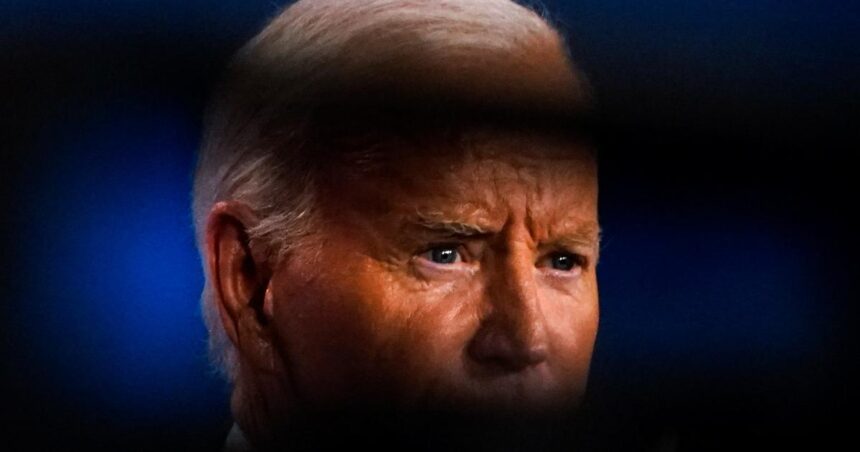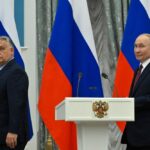Summary by Geopolist | Istanbul Center for Geopolitics:
The article from Foreign Affairs explores how the aging of U.S. leaders, particularly President Joe Biden and former President Donald Trump, affects American politics and its global standing. Here’s a summary:
Key Points:
1. Aging Leadership in the U.S.:
- Concerns about Age: The increasing age of major U.S. political figures has sparked concerns about their capacity to lead effectively. Both President Biden and former President Trump, both in their 80s, face scrutiny regarding their age and potential cognitive decline.
2. Different Reactions and Implications:
- Biden’s Leadership Style: President Biden’s leadership is characterized by a more traditional and measured approach, which some critics attribute to age-related factors. His administration faces challenges in balancing experience with the demands of modern governance.
- Trump’s Persona and Health: Former President Trump, who also faces age-related concerns, presents a different case. His leadership style is more unconventional and confrontational, and despite health issues, he maintains a significant influence on American politics and the Republican Party.
3. Impact on American Power:
- Domestic and International Effects: The aging of key leaders raises questions about the stability and efficacy of U.S. leadership. This concern is compounded by the need for strong, decisive leadership in both domestic and international arenas, as the U.S. navigates complex global challenges.
4. Public Perception and Political Dynamics:
- Perception of Competence: The public’s perception of competence and vitality in aging leaders can influence political dynamics, affecting electoral outcomes and policy decisions. Age-related concerns could impact voter confidence and shape the political landscape.
5. Future Considerations:
- Need for Succession Planning: The article suggests that the U.S. needs to address succession planning and the potential impact of aging leadership on the country’s global role. Ensuring robust systems for leadership transition and fostering new political talent may become increasingly important.
In summary, the article highlights how the advanced age of prominent U.S. leaders like Biden and Trump affects perceptions of their leadership and the broader implications for American politics and global standing. The challenges and dynamics associated with aging leaders underscore the need for effective succession planning and strong leadership in addressing both domestic and international issues.
For more details, read the full article here below.
The Senile Superpower?
At age 81, U.S. President Joe Biden is objectively old, but what was striking about his June 27 debate with former U.S. President Donald Trump was just how old he looked and sounded. In the weeks since, Biden’s unsettling performance has triggered a political crisis within the Democratic Party. His campaign has claimed that the president merely had “a bad night” and has cited, among other things, the clean bill of health from his yearly physical exams and the exhaustion induced by recent foreign travel. But that has not stopped a growing number of Democrats from calling for Biden to bow out of the race, driven by fears that he has little chance of defeating Trump.
Yet there is more at stake than electoral odds. History suggests that old leaders who betray visible signs of senility, whether or not these encapsulate actual cognitive decline, will be treated differently by their foreign counterparts. And the problem of an aging president does not apply to Biden alone. His debating partner is hardly a model of youthful sharp-mindedness. In his appearances this year, Trump, 78 years old, has shown moments of confusion, unrelenting digressions, striking ignorance, and egregious (but perhaps partly intentional) misrepresentations—although the apparent vigor he showed right after the assassination attempt against him cuts in the other direction. Still, for both Biden and Trump, a second term carries the risk that doubts about the president’s competence will permeate international diplomacy and burden U.S. foreign relations.
In a study published last year, we looked at historical cases to answer the question of how aging leaders are seen in international politics. We focused on top-level U.S. appraisals of two aging titans of Cold War Asia, Syngman Rhee of South Korea and Mao Zedong of China—views that featured abrupt changes over time that could not simply be attributed to the men’s chronological aging. We found that foreign observers use physical, emotional, and cognitive indicators as vital clues to assess elderly leaders and that leaders who repeatedly show telltale signs of age-related decline are treated differently—not just compared with younger leaders but also compared with old leaders who show fewer signs of decline.
When a leader exudes agedness, adversaries may drive a harder bargain or adopt more aggressive foreign policies, expecting a weaker response. Allies and partners may question the promises that an old leader makes or bypass what they see as an aging figurehead by working with other officials. They may even postpone substantive diplomacy altogether. But policymakers may also update their assessments of leaders through continued contact, giving old leaders a chance to recover their reputations for competence and relevance. When it comes to assessments of vigor in international politics, seeing is believing.
AN OLD STORY
Aging leaders have been a fixture on the world stage for centuries. In earlier eras, elderly monarchs were the norm. Today, aging dictators and democratically elected heads of state are common. But a leader’s age alone tells us little. Old age can be a source of wisdom or a driver of mental decline. How does one tell the difference? In everyday life and in diplomacy, people use tells of senility—that is, signs of confusion, physical weakness, or loss of focus that correspond to widely held stereotypes about age-related decline.
This should not be news to the White House. U.S. officials themselves have routinely scrutinized their elderly foreign counterparts for telltale signs of senility, basing harsh judgments on many of the same indicators that observers focused on after Biden’s debate performance—his raspy voice, halting speech, frail movements, meandering answers, and apparent forgetfulness.
When a leader exudes agedness, adversaries may expect a weaker response.
In 1964, for example, a CIA summary of a meeting between Chester Bowles, then the U.S. ambassador to India, and Jawaharlal Nehru, India’s 74-year-old prime minister, described Nehru as “weak” and speaking “with painful slowness.” (He ended up dying of a heart attack just weeks after the meeting.) In 1979, likewise, the U.S. embassy in Saudi Arabia reported after a meeting with King Khalid bin Abdulaziz al-Saud, then 66 years old, that “the king appeared feeble; especially noticeable were his somewhat disoriented remarks along with an extremely short attention span.” And throughout the 1970s and early 1980s, U.S. policymakers tried to determine whether and how the aging of Soviet leader Leonid Brezhnev might be shaping his competence and power within the Politburo. After a 1977 meeting, Secretary of State Cyrus Vance remarked that the 71-year-old Soviet leader appeared “in a daze,” “out of touch with his surroundings,” and “heavily dependent on those around him in getting through his audiences.” To Vance, this was “strongly suggestive of an aging individual whose reserve strength is essentially depleted.”
U.S. officials viewed some elderly leaders in a more favorable light. In 1959, the CIA station in Bonn, West Germany, made sure to warn Washington that the 83-year-old West German chancellor Konrad Adenauer’s behavior in the ongoing Berlin crisis “should not be ascribed to senility,” given that he had shown himself “physically firm and mentally alert” in “close quarters.” The elderly Zhou Enlai, China’s prime minister for much of the Cold War, held numerous meetings with foreign partners that showcased his vigor and intellectual sharpness. After meeting with a 73-year-old Zhou in 1971, National Security Adviser Henry Kissinger wrote in a memo that he “ranks with Charles De Gaulle as the most impressive foreign statesman I have met.”
To better understand how assessments of old leaders have shaped international diplomacy, we used declassified archival records to dig deeper into U.S. appraisals of Rhee and Mao. Evolving views of their agedness evident in top decision-making circles highlight the importance of verbal and physical cues. These two cases also underscore how foreign suspicions of senility can have significant ramifications for foreign policy.
RESPECT YOUR ELDERS?
Rhee became the focal point of U.S. policy in South Korea after becoming the country’s first president at the age of 73. U.S. officials were often unhappy with how Rhee, whose country they were defending in the Korean War, conducted his foreign and domestic affairs. But most also admitted that he was—in the opinion of one U.S. general summarized in a 1952 memo—“a shrewd, astute, hard-bargaining, old patriot, who knows how to get what he wants and usually does.” As that description shows, old age can be seen as positive rather than negative. For U.S. policymakers, it followed that the best way for the United States to deal with South Korea was to, in the words of a State Department official in 1953, “convince him that working with us is the best way of achieving the objective to which he has dedicated his life”—namely, securing his country’s independence against external aggression.
The mood changed in the late 1950s, however, when U.S. officials in South Korea increasingly took note of Rhee’s apparent senility. On a 1956 visit, U.S. Secretary of State John Foster Dulles remarked that “Rhee showed evidence of having greatly aged,” adding, “I tried to give him some of the impressions of my trip, but he showed little interest, and he did not follow what I was saying.” Walter Dowling, the U.S. ambassador to South Korea, repeatedly reported on how the president was “beginning to look and act like a very old man,” as he put it in 1957. One among many signs of “marked deterioration,” the ambassador wrote two years later, was that “he is increasingly forgetful, and that it is necessary to explain and re-explain ideas and suggestions before [he] grasps meaning or significance.” Peer De Silva, the CIA station chief in Seoul, recounted in his memoir that by 1959, it was “common knowledge that Syngman Rhee … was rapidly sliding into senility.”
Declassified American records make clear that such prevailing assessments informed a broader loss of faith in Rhee as a strategic partner, prompting Washington to quietly back his domestic political opponents, who removed him from power in 1960. “It is clear that he is superannuated and has lost the capacity to distinguish between the political forces of the past and those of the present and the future,” the CIA observed five days prior to Rhee’s ouster; the proper role of the United States was to help “ease him out of power altogether with his party lieutenants.” During his final meeting with Rhee, Walter McConaughy, the U.S. ambassador to South Korea, delivered a harsh message: although the United States viewed him as the “George Washington” of South Korea, it was time for this “elder statesman” to turn the burdens of government “over to younger men.”
FROM SENILE TO SHARP
During the 1960s, Mao rarely appeared in public, and U.S. policymakers had no firsthand access to him in diplomatic meetings. Deriving what they could from third-hand accounts and hearsay, many in Washington assumed that the reclusive leader was suffering from senility. One example of such indirect evidence, according to a 1964 CIA report, was that “Mao was once a forceful speechmaker and prolific and effective writer, but no important production has been claimed for him since 1957.”
This assumption narrowed the range of policies that the United States was willing to consider in its relations with China. Years before Nixon’s famous opening to China, some in the U.S. government advocated rapprochement with Beijing to turn it into a strategic partner against the larger Soviet adversary. One reason that such proposals failed to gain traction was perceptions about Mao’s age-induced decline. The old dictator, the argument ran, would be too rigid and incompetent to make an overture worthwhile.
It was not until Kissinger saw Mao’s performance in person during his visits to China in the early 1970s that American views began to change. Kissinger’s analysis from face-to-face meetings with Mao contain numerous references to clues about aging. “Mentally he was extremely impressive,” Kissinger wrote to Nixon in 1973, adding that the elderly chairman “led the conversation” and “covered all major international issues with subtlety and incisiveness.” He went on: “And all of this was done without a single note of his own.” Explaining why previous encounters had fueled concerns about Mao’s age, including those Nixon had after meeting Mao on his famous visit the previous year, Kissinger noted, “It is now clear in retrospect that he was quite ill when you saw him.”
More optimistic assessments of Mao’s competence that resulted from the face-to-face encounters of the early 1970s helped expand U.S. ambitions for diplomatic engagement with China. After all, American leaders had believed from the initial stages of rapprochement that Mao’s personal condition and domestic status in China was one of the most important wildcards that, as Kissinger put it in 1973, carried “substantial potential for trouble in our relationship.” With these concerns largely allayed, U.S. policymakers could reach for deeper levels of cooperation, opening the door to compromises and understandings throughout the rest of the decade on a wide range of issues involving Southeast Asian politics, the Korean Peninsula, and arms control.
ACTING THEIR AGE
When he took office, Trump set the record for the oldest president at the start of his term—a record Biden then broke at the start of his. Should either candidate serve out a second term, he would be 82 or 86, respectively, by the end. Indeed, despite the attention paid to Biden now, the problem of an aging U.S. president on the international stage will not be his alone. Even if one believes that Trump’s verbal and physical signs of aging are milder, foreign counterparts will be rendering senility-related judgments about Trump, too. Either candidate’s victory would invite questions about the age-related decline of the U.S. president—and its foreign policy ramifications. And continued aging will only sharpen those concerns.
History suggests that the foreign policy risks of such concerns are substantial. Adversaries may conclude that the aging president is a compromised figure within U.S. domestic politics. Russian President Vladimir Putin, for example, may then feel emboldened to take more risks in Ukraine. Personal connections among heads of state may also suffer. Biden, for his part, has often highlighted his extensive personal meetings with Chinese leader Xi Jinping. If the president is seen as suffering from age-related decline, however, Xi may place less value in such a dialogue. That may make it harder for the United States and China to, say, defuse a future crisis over Taiwan.
When it comes to vigor in international politics, seeing is believing.
Allies and partners may also recalibrate their diplomatic efforts in response to an age-weakened American president. For example, if allied leaders in European capitals doubt Biden’s competence in a second term, NATO’s unity may suffer. In Trump’s case, doubts among allies about his dedication to the United States’ traditional security commitments will only grow if they see him exhibiting stereotypical traits of senility, such as curmudgeonly stubbornness and an unwillingness to learn. In the extreme, just as U.S. leaders bypassed a seemingly senile Rhee in favor of his advisers, foreign capitals may look to bypass the president in favor of lower-ranking departmental heads and bureaucratic counterparts.
But the historical record also suggests that over time an aging leader can repair his international image. Mao changed U.S. perceptions of his age-related decline through face-to-face meetings. So could Trump or Biden.
There is some precedent for this. There were many doubts about President Ronald Reagan’s mental acuity in his second term, which he began at the age of 73. Yet Reagan was able to engage in intense one-on-one diplomacy with Soviet leader Mikhail Gorbachev, which helped set the stage for the peaceful conclusion of the Cold War. In one encounter during the 1985 Geneva Summit, Reagan actively sought to demonstrate youthfulness. When Gorbachev emerged from his limousine, wearing an overcoat to protect him from the cold, Reagan left off his overcoat and bounded down a set of stairs to greet the Soviet leader. The result was that, in the words of Jack Matlock, a White House aide at the time, “even though Reagan was much older, Gorbachev came across as the spiritually older person.”
Before the Biden-Trump debate, many foreign leaders and governments had surely drawn conclusions about Biden’s acuity from in-person meetings, just as they surely had about Trump’s acuity from encounters with him when he was president. But such optics are not only an electoral liability. The United States’ own treatment of aging foreign leaders in the past makes clear that when presidents are seen as suffering from the ravages of time, their standing abroad will also take a hit.
By Joshua Byun and Austin Carsons
Source: Foreign Affairs







